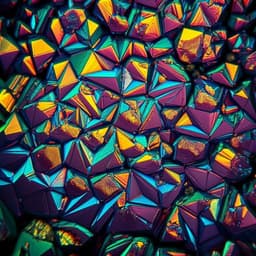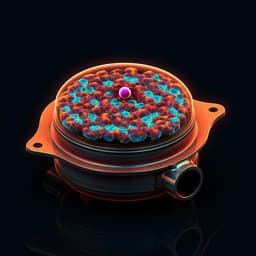
Chemistry
Single-atom catalyst for high-performance methanol oxidation
Z. Zhang, J. Liu, et al.
Discover the groundbreaking research conducted by Zhiqi Zhang and colleagues, showcasing a novel single-atom catalyst that dramatically enhances electrocatalytic activity for methanol oxidation. The innovative Pt1/RuO2 catalyst outperforms traditional Pt/C by 15.3 times, demonstrating remarkable catalytic stability and CO poisoning tolerance. A significant step forward for electrochemical alcohol oxidation!
~3 min • Beginner • English
Introduction
The study addresses the long-standing challenge of achieving high-activity and CO-tolerant methanol oxidation reaction (MOR) catalysts with minimal Pt loading for direct methanol fuel cells. While Pt nanoparticles are effective for MOR, their mass activity is limited by particle size (>1 nm) and susceptibility to COads poisoning. Single-atom catalysts (SACs) maximize metal utilization and can facilitate CO oxidation, yet isolated Pt atoms on carbon supports have been reported inactive for MOR, likely because methanol dehydrogenation to CO requires ensembles of contiguous Pt atoms. The authors hypothesize that engineering the coordination environment of single Pt atoms via an oxide support (RuO2) can activate single-atom Pt for MOR by creating favorable Pt–O–Ru interfacial motifs and leveraging oxophilic sites to assist dehydrogenation and CO removal. The purpose is to synthesize and evaluate Pt SACs on RuO2 (Pt1/RuO2) versus carbon (Pt1/VXC-72), elucidate structure–activity relationships, and understand the MOR mechanism via combined experiments and DFT.
Literature Review
Prior work has enhanced MOR by tailoring Pt nanostructures (hollow, frame, core–shell) and alloying or interfacing with Co, Ni, Sn, Bi, etc., but these remain nanoparticle-based with limited mass activity and CO poisoning issues. SACs have shown exceptional activity in other electrocatalytic reactions (OER, HER, ORR, CO2 and N2 reduction, FAOR), and Pt SACs can promote CO oxidation. However, previous studies found Pt single atoms on carbon nanotubes inactive for MOR, attributing inactivity to the need for multi-atom Pt ensembles for methanol dehydrogenation. The coordination environment of single atoms strongly influences catalytic properties and can be tuned by substrate bonding. This motivates exploring oxide-supported Pt SACs with different coordination than carbon supports to potentially activate MOR.
Methodology
Synthesis: Pt1/RuO2 and Pt1/VXC-72 were prepared by an impregnation-adsorption method: RuO2 (or VXC-72) dispersed in water, H2PtCl6 solution added dropwise, stirred at 70 °C for 5 h, followed by filtration, washing, and drying (70 °C overnight). Pt loading was 0.38 wt% unless stated. Control samples included: Pt1/RuO2-500 and Pt1/RuO2-700 (air annealing at 500 or 700 °C to aggregate Pt into nanoparticles), and Pt1/RuO2-H (H2 reduction at 80 °C to partially reduce RuO2 to Ru, altering Pt coordination).
Characterization: Morphology and dispersion assessed by TEM and HAADF-STEM with EDS mapping; XRD for phase analysis; XPS for Pt 4f and O 1s states (deconvolution to separate Ru 4s); XAFS (XANES/EXAFS) at Pt L3-edge for oxidation state and coordination (Fourier-transformed EXAFS, wavelet transform); EPR; UV–vis quantified Pt content in catalysts.
Electrochemistry: Three-electrode cell (glassy carbon working electrode, graphite counter, Ag/AgCl reference; potentials converted to RHE). Inks: catalyst + VXC-72 in water/ethanol/Nafion; 5 µL drop-cast on 4 mm GC disk. MOR/EOR CVs in N2-saturated 0.1 M KOH with 1 M methanol or ethanol at 50 mV s−1. Stability by chronoamperometry at −0.1 V vs Ag/AgCl for 10 h. CO stripping: CO adsorption at −0.95 V vs Ag/AgCl for 10 min in 0.1 M KOH; purge CO with N2 for 20 min; strip from −0.95 to 0 V at 50 mV s−1 (two scans). Mass activities normalized to Pt mass.
Computations: Spin-polarized DFT (VASP, PAW, PBE-GGA, 400 eV cutoff, dipole correction). Models: Pt at Rucus site on RuO2(110) (Pt-RuO2(110), representing Pt1/RuO2); Pt bonded to 3 C on graphene (PtC3, representing Pt1/VXC-72); Pt substituting surface Ru in Ru(0001) (Pt-Ru(0001), representing Pt1/RuO2-H). Slab models with appropriate vacuum; k-point sampling ≤ 2π×0.04 Å−1. Transition states located by NEB and dimer methods (single imaginary frequency confirmed). Adsorption/binding energies, Gibbs free energies including ZPVE and entropic corrections at 298 K; pH corrections; computational standard hydrogen electrode used to evaluate onset potentials. PDOS, charge density difference, and Bader charge analyses performed to understand electronic structure and bonding.
Key Findings
- Structure and coordination: HAADF-STEM shows atomically dispersed Pt on both RuO2 and VXC-72; no Pt-Pt EXAFS peak, confirming single-atom dispersion. In Pt1/RuO2, Pt exhibits Pt–O coordination (dominant EXAFS peak at 1.62 Å; coordination number ~4; bond length ~1.99 Å). In Pt1/VXC-72, Pt–C coordination dominates (peak at 1.83 Å; CN ~3; bond length ~1.93 Å). XANES indicates higher oxidation state for Pt in Pt1/RuO2 than in Pt1/VXC-72; estimated average Pt oxidation states +2.90 vs +1.22. XPS Pt 4f binding energies: 73.6/76.9 eV (Pt1/RuO2) vs 72.9/76.2 eV (Pt1/VXC-72). O 1s of Pt1/RuO2 shows a new ~531.3 eV peak attributed to oxygen vacancies.
- MOR activity (0.1 M KOH, 1 M MeOH, 50 mV s−1): Pt1/RuO2 exhibits pronounced oxidation peaks; RuO2 alone is inactive; Pt1/VXC-72 is inactive. Pt mass activity for Pt1/RuO2: 6766 mA mgPt−1 at 0.80 V vs RHE, 15.3× higher than commercial 20 wt% Pt/C (441 mA mgPt−1 at 0.92 V). If/Ib ratio (COads tolerance indicator): 3.67 for Pt1/RuO2 vs 1.81 for Pt/C. Stability: After 10 h chronoamperometry at −0.1 V vs Ag/AgCl, Pt1/RuO2 retains 6463 mA mgPt−1 (−4.5%), while Pt/C drops to 344 mA mgPt−1 (−22%). Post-test microscopy: Pt atoms remain isolated on RuO2; Pt/C nanoparticles aggregate.
- Controls: Thermal aggregation (Pt1/RuO2-500, 1–2 nm Pt NPs) lowers mass activity to 2140 mA mgPt−1; Pt1/RuO2-700 (∼30 nm Pt) shows no MOR peak. Reducing support (Pt1/RuO2-H) changes coordination to Pt–Ru (EXAFS peak at 2.49 Å, CN ≈ 9) and abolishes MOR activity. Higher Pt loadings that form clusters/NPs reduce mass activity.
- CO stripping (0.1 M KOH): Onset potentials: Pt/C 0.448 V; Pt1/VXC-72 ~0.276 V; Pt1/RuO2 0.152 V with a small peak at ~0.673 V; RuO2 0.076 V. These show enhanced CO electrooxidation at lower potentials for Pt1/RuO2, indicating strong anti-poisoning.
- EOR (alkaline): Pt1/RuO2 shows ~5.7× higher mass activity than Pt/C (2824 vs 498 mA mgPt−1).
- DFT mechanistic insights: On Pt-RuO2(110), methanol adsorbs favorably (ΔGads = −0.54 eV), O–H scission is spontaneous via Obr. Predicted MOR pathway: CH3OH* → CH3O* → CH2O* → CHO* → CO*, with activation barriers 0.39, 0.49 (rate-limiting), and 0.29 eV, respectively. The CH2O* dehydrogenation barrier is reduced vs RuO2(110) (0.49 vs 0.71 eV). On PtC3 and Pt-Ru(0001), methanol adsorption is weaker (−0.03 and +0.15 eV) and barriers are much higher (max barriers 2.06 eV for PtC3; 1.08 eV for Pt-Ru(0001)), explaining inactivity. Predicted onset potentials (potential-determining step CH3O* → CH2O*): 0.26 V (Pt-RuO2(110)), 0.92 V (PtC3), 0.33 V (Pt-Ru(0001)). CO oxidation on Pt-RuO2(110) proceeds via CO* + OH* → cis-COOH* → trans-COOH* → CO2* with a rate-limiting cis → trans rotation barrier of 0.35 eV; CO desorption to CO2* is favorable (ΔG = +0.33 eV for desorption). CO adsorbs more weakly on Pt-RuO2(110) (−0.54 eV) than on PtC3 (−0.81 eV) or Pt-Ru(0001) (−0.92 eV), correlating with lower oxidation barriers and better CO tolerance.
- Electronic structure: PDOS and Bader analysis show Pt and Ru in Pt-RuO2(110) lose 1.22 e and 1.61 e, respectively; Ru d z2 orbital is empty while Pt’s spin-up d z2 is filled. Stronger interaction between adsorbates and Ru than Pt raises CH2O* energy on Pt-RuO2(110), lowering the TS barrier (TS2). Pt d-orbitals on Pt-RuO2(110) are more delocalized with higher DOS near EF than on Pt-Ru(0001) or PtC3, facilitating electron transfer and MOR kinetics.
Discussion
The findings confirm that engineering the coordination environment of Pt single atoms via an oxophilic RuO2 support activates MOR, despite prior reports of SAC Pt on carbon being inactive. The Pt–O3–Ru motif with adjacent bridging O on RuO2(110) creates sites that: (i) promote facile O–H cleavage in methanol, (ii) lower the rate-limiting CH2O* dehydrogenation barrier relative to bare RuO2, and (iii) weaken CO adsorption while enabling low-potential CO electrooxidation assisted by OH from RuO2. Consequently, Pt1/RuO2 exhibits markedly higher mass activity and CO tolerance than commercial Pt/C, and far outperforms Pt1/VXC-72 and Pt1/RuO2-H. Control experiments (thermal aggregation and support reduction) underscore the necessity of isolated Pt atoms and the specific Pt–O coordination on RuO2 for activity. The complementary experimental and computational evidence directly links the tailored local coordination and electronic structure to superior MOR kinetics and stability in alkaline media.
Conclusion
This work demonstrates a single-atom Pt catalyst on RuO2 (Pt1/RuO2) that achieves exceptional MOR performance in alkaline media, with mass activity of 6766 mA mgPt−1 and strong resistance to CO poisoning, surpassing commercial Pt/C. The activity originates from the Pt–O3–Ru configuration with neighboring Obr that accelerates methanol dehydrogenation and enables low-potential CO electrooxidation. The study establishes coordination engineering of single-atom centers via oxide supports as a viable strategy to activate alcohol oxidation on Pt SACs. Future research could extend this approach to other alcohols, probe performance in acidic or device-relevant environments, optimize supports and Pt loadings, and explore other metal–oxide combinations to generalize the design principles.
Limitations
- Measurements were conducted in alkaline electrolyte (0.1 M KOH) with dissolved methanol; performance under acidic conditions or in full direct methanol fuel cells was not evaluated.
- Durability assessment was limited to 10 h; longer-term stability, cycling, and real-device operation were not reported.
- Activity metrics rely on low Pt loading SACs; scalability, support conductivity under practical loadings, and potential Pt migration/aggregation over extended use require further study.
- Mechanistic insights are based on model DFT slabs and idealized surfaces; real catalyst surfaces may include heterogeneity not fully captured by the models.
Related Publications
Explore these studies to deepen your understanding of the subject.







